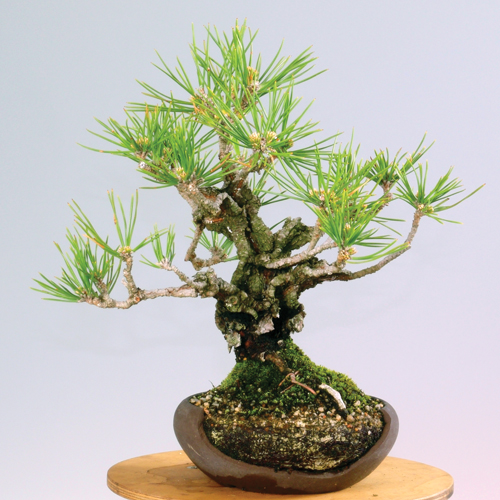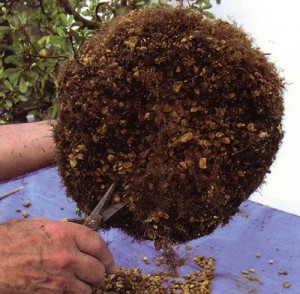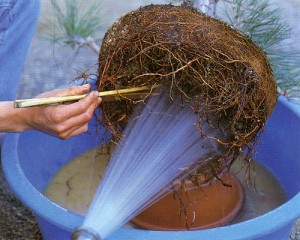
Time to repot. Morten Albek intentionally broke the pot to show this Cork bark Japanese black pine’s dense root mass. From Morten’s book, Shohin Bonsai (Stone Lantern Publishing).
Why transplant in the fall?
If you transplant in the fall your trees can take full advantage of the next growing season. If you transplant in the spring (that’s when most people do it), by the time the tree recovers, you’ve lost part of the growing season.
Why not transplant in the fall?
If you have an early winter and your bonsai haven’t fully recovered from transplanting, then you risk serious damage (or worse). If you rootprune heavily, the risk goes up. If you want to play it safe, fall transplant only those trees that need light to moderate root pruning.

Doing some light rootpruning. From Robert Callaham’s Satsuki Azaleas, for Bonsai and Azalea Enthusiasts (Stone Lantern Publishing).
When?
Fall transplanting season is coming up. When depends mostly upon where you live. There are other considerations too, like the type of tree, the health of the tree, your experience and confidence, how much you need to prune off the roots and more.
A rule of thumb
Six weeks before you might expect an early hard frost, is a pretty good rule of thumb for fall transplanting. However, you can’t be too literal about this. Prolonged late hot spells need to be considered (here in northern Vermont, where summers are more often than not quite mild, this usually is not a problem) as does how much you need to rootprune and the type of tree.

If the soil is old and compacted you need to remove it all (there are exceptions, but this usually applies). A hard steam of water and roots tools are the best way to get it all off. Because the roots are so compacted, you’ll need to do some serious rootpruning. Unless you are an old pro, you might be better off saving this for spring transplanting. From Bonsai Today issue 17 (out of print).
The type of tree matters
Deciduous trees need special consideration as you don’t want to rootprune when they have a full canopy of leaves. Conifers, especially junipers, and broad leaf evergreens are usually safest for fall transplanting, though there are variables here too. If you need more information, try to talk to someone knowledgeable who lives in your area.
Don’t forget aftercare
After transplanting, your margin of error goes down, especially with watering. Stay posted for something on aftercare.
Our Green Workshops are designed to help relative beginners with basic bonsai principles and practices. On last one was on watering.
I live in Arizona and I have an italian stone pine. Is it ok to transplant my tree in fall? I just started Bonsai and am barely learning. So I will be very thankful for any help
Hi Joseph,
I don’t know too much about Stone pines (nor do I know where in Arizona you live), but there’s always google. Here are a couple related to bonsai:
http://ibonsaiclub.forumotion.com/t1988-italian-stone-pine-care
http://bonsainut.com/forums/showthread.php?3282-Italian-Stone-Pine-Care!
One question that comes to mind is: does it need transplanting right now, or can you wait while you learn more about bonsai in general and Stone pines specifically?
Another question is: where in Arizona do you live. If your night temps aren’t very cold and you could keep it outside for most of the winter, then maybe fall transplanting would work. This assuming a healthy tree before you start.
Thank you Wayne , it really good to know that if I have any questions I can just email you and I get a quick respone. I live in Tucson, Arizona, my tree is very healthy and yes I can wait. Thank You.